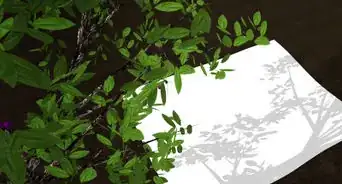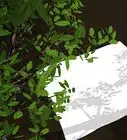This article was co-authored by wikiHow Staff. Our trained team of editors and researchers validate articles for accuracy and comprehensiveness. wikiHow's Content Management Team carefully monitors the work from our editorial staff to ensure that each article is backed by trusted research and meets our high quality standards.
wikiHow marks an article as reader-approved once it receives enough positive feedback. This article received 28 testimonials and 92% of readers who voted found it helpful, earning it our reader-approved status.
This article has been viewed 691,922 times.
Learn more...
"Water bears" is a colloquial name for tiny multicellular critters that have always delighted microscopists. They are properly called tardigrades ("slow walkers"), and with four pairs of stumpy legs and lumbering gait, they do look a little like a microscopic bear (an eight legged, microscopic bear, that is). Tardigrades live in more places on Earth than humans do, so practically any handful of water has a chance of containing some. The easiest way to find them and care for them, however, is to look in scraps of wet moss.
Steps
Finding Tardigrades
-
1Learn about tardigrades. These critters may be microscopic, but they are very cool! Tardigrades, also called water bears, are some of the most amazing animals on Earth, and live just about everywhere you can imagine. They can survive:[1] [2]
- Temperatures as low as -200 °C (-328 °F) and as high as 151 °C (304 °F)
- Freezing in a block of ice
- Lack of oxygen for days, possibly months
- Lack of water for decades
- Levels of X-ray radiation 1,000 times the lethal human dose
- Many noxious chemicals
- Boiling alcohol
- Low pressure of a vacuum, like that of space
- Extreme pressure, up to six times greater than found at the deepest part of the ocean
- Note that they can only survive these conditions in cryptobiosis. If you exposed a living tardigrade to these conditions, it would die instantly.
-
2Look for a moist tardigrade habitat. Many tardigrades are aquatic, but the easiest place for humans to find them is in damp moss, lichen, or leaf litter. Search in forests, around ponds, or even in your backyard. Your best bet is to look in damp places, where tardigrades are active. You can get a sample of dry habitat if nothing else is available, since it may contain tardigrades in an extreme hibernation state (cryptobiosis), waiting for water to rejuvenate them.[3]Advertisement
-
3Collect a sample of the moss or lichen with tweezers. Put the sample in a paper bag or envelope so it can dry out a little. (A plastic bag will trap the water and encourage mold to grow, which will block your view of the animals.)[4]
- You can take samples of several different kinds of moss, lichen, or leaf litter to see whether tardigrades like one more than another.
- Soft lichen is more likely to have tardigrades than hard, crusty lichen. You can even find water bears in the powdery lichen that grows on rocks and brick walls.
Setting Up the Tardigrade Shelter
-
1Put the samples in a petri dish. You only need a tiny pinch of the material in each petri dish. If you don't have a petri dish, you can use any small, clear plastic container. Blister packs that used to hold pills are a good option.[5]
-
2Soak the moss or lichen completely. Add water, preferably distilled or rainwater, until there is one centimeter in the petri dish. Let soak for 8 to 24 hours, to make the water bears active.
-
3Squeeze the water from the moss into a new petri dish. Squeezing or shaking their habitat will release the microscopic creatures into the water.
-
4Find a low power microscope. Most tardigrades are about a quarter to a half millimeter long. That's almost at the range of human sight, a little smaller than a period. It only takes a microscope with about 15x or 30x magnification to spot one.[6] If you don't have one, look for a cheap stereo microscope online.
-
5Look for tardigrades. Set the microscope up over the petri dish and focus it on the moss. It helps to shine a powerful flashlight horizontally, through the side of the petri dish. This will make the tardigrades and other creatures glow white.[7] Look for an animal with four pairs of stubby legs, waving and grasping in slow motion to move its blobby body. The last pair of legs faces backward, so you might mistake it for a tail or the end of its body.
- If there is a water bear, you've struck the jackpot. Pour the water back to the moss to set up a home for it.
- If you don't see any after moving the petri dish around for a while, replace the water and try again with a different piece of moss until you find one.
Caring for the Tardigrades
-
1Feed the tardigrade. Water bears suck out juices from moss, algae, and lichen to feed.[8] Put a bit of plant matter in once a month, or replace the old stuff if it starts to turn moldy or decompose.
- Water Bears also eat nematodes, little worm-shaped creatures, and rotifers, tiny plankton. Try to find nice, wet moss for the Water Bears as that is most likely to contain their prey.
- Some tardigrades live in freshwater and others live in saltwater. Stick to water and plants from the same type of environment where you collected your tardigrades.
-
2Replace the water in the petri dish once it dries out. Tardigrades will usually survive in a dry state, but it's not guaranteed. Be nice to your water bears and keep them wet.
- Dried out tardigrades are smaller and completely immobile. You might not be able to spot them, but you'll see them again if you give them a good soak.
-
3Enjoy caring for tardigrades. They won't mind if you look at them under the microscope once in a while. If you're lucky, you might see them shedding their hard outer cuticle, laying eggs, or hatching.
Community Q&A
-
QuestionCan I name them?
 Community AnswerYes, you could name your water bears. However, it would most likely not be recommended with more than one tardigrade, seeing as they are almost identical, and you would most likely get them mixed up. Maybe you could give them all the same name.
Community AnswerYes, you could name your water bears. However, it would most likely not be recommended with more than one tardigrade, seeing as they are almost identical, and you would most likely get them mixed up. Maybe you could give them all the same name. -
QuestionWhere does a tardigrade find food?
 Community AnswerWhen you bring it fresh moss every month, there are little microorganisms that are plentiful for it to eat. It don't need anything other than that.
Community AnswerWhen you bring it fresh moss every month, there are little microorganisms that are plentiful for it to eat. It don't need anything other than that. -
QuestionCan my water bear die?
 Community AnswerYes, as with any living creature. However, it is the strongest living being known, it can 'revive' with water after total lack of water and when water reaches these bears, their bodies absorb fragments of DNA around them and mutate. In some cases, some get stronger.
Community AnswerYes, as with any living creature. However, it is the strongest living being known, it can 'revive' with water after total lack of water and when water reaches these bears, their bodies absorb fragments of DNA around them and mutate. In some cases, some get stronger.
Warnings
- While you are searching for tardigrades, be considerate of the environment around you. Don't disturb animals and leave everything as you found it.⧼thumbs_response⧽
Things You'll Need
- Tweezers (for handling)
- Paper bag
- Petri dish
- Damp moss, lichen, or leaf litter
- Rain or distilled water
- Microscope
- Flashlight
- Nematodes
References
- ↑ https://sun.iwu.edu/~tardisdp/tardigrade_facts.html
- ↑ http://www.bbc.com/earth/story/20150313-the-toughest-animals-on-earth
- ↑ https://sun.iwu.edu/~tardisdp/tardigrade_facts.html
- ↑ http://www.microscopy-uk.org.uk/mag/indexmag.html?http://www.microscopy-uk.org.uk/mag/artoct11/ms-tardigrades.html
- ↑ http://www.microscopy-uk.org.uk/mag/indexmag.html?http://www.microscopy-uk.org.uk/mag/artoct11/ms-tardigrades.html
- ↑ http://www.microscopy-uk.org.uk/mag/indexmag.html?http://www.microscopy-uk.org.uk/mag/artoct11/ms-tardigrades.html
- ↑ http://www.microscopy-uk.org.uk/mag/indexmag.html?http://www.microscopy-uk.org.uk/mag/artoct11/ms-tardigrades.html
- ↑ http://infinitespider.com/tardigrades-introducing-moss-piglet-water-bear/
- ↑ http://www.sciencedirect.com/science/article/pii/S0960982202009594
About This Article
To find a pet tardigrade, collect a moist piece of moss or lichen with tweezers. Place that sample in a paper bag to dry out a little. Then, put the sample in a petri dish and soak it in distilled water for 8 to 24 hours to make the water bears active. Next, squeeze the water out of the moss and into a new petri dish and look at them through a low powered microscope. To learn how to care for a pet tardigrade, read on!
-Step-1-Version-2.webp)
-Step-2-Version-2.webp)
-Step-3-Version-2.webp)
-Step-4-Version-2.webp)
-Step-5-Version-2.webp)
-Step-6-Version-2.webp)
-Step-7-Version-2.webp)
-Step-8-Version-2.webp)
-Step-9-Version-2.webp)
-Step-10-Version-2.webp)
-Step-11-Version-2.webp)




-Step-10.webp)


















































